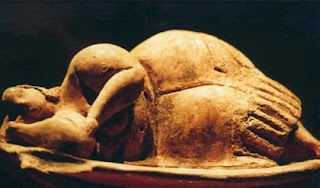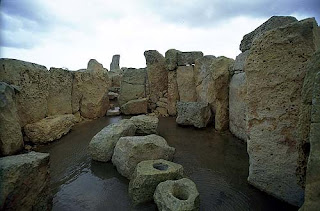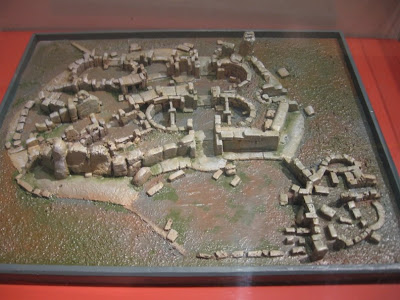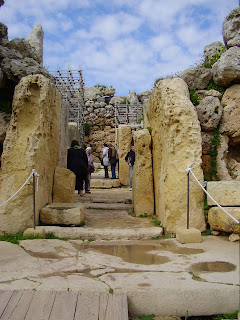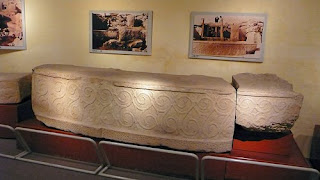 Citadel of Victoria (Rabat)
Citadel of Victoria (Rabat) Rotunda Church Xewkija
Rotunda Church XewkijaThe island of Malta is the fourth most densely populated place in the world and particularly on the north coast has a very urban character with one town running into the other. For many visitors to the Maltese Archipelago its sister island Gozo is the real deal, less populated, greener, more relaxed and very traditional with a definite sense of identity.

 Port of Mgarr which connects Gozo to Malta
Port of Mgarr which connects Gozo to MaltaIn Gozo, don't commit the faux pas of referring to them as Maltese, they are "Gozitans" and even the Maltese will tell you that the Gozitans don't like them! Greener and more atmospheric than Malta even the buses are a different colour, yellow on Malta and grey on Gozo. Gozo meaning “joy” in Castilian is the name the Aragonese gave this island, when they possessed it in 1282. The idea of joy and pleasure is also conveyed by its Latin motto
“Fertilis ab undis caput iffero – a fruitful land raising its head from the sea”. We know that the Phoenicians, when it was theirs in 700Bc, called it “Gwl” or Gaulos, meaning a round ship, possibly in reference to the island’s shape from a distance, a name the Romans kept when they, in turn took it over in 218 AD. The Arabs, who came to rule this precious piece of land a thousand years ago, and who strongly influenced its Semitic language, left behind the name that has stuck in the vernacular: Ghawdex (pronounced Aw-desh).
 Gozitan Bus
Gozitan BusIt has an area of 67 square kms, is 14 kms long and 7 kms wide. With a coastline of 43 km, it is the second largest island of the Maltese Archipelago that, together with the smaller isle of Comino and the main island of Malta forms the Republic of Malta. Gozo is popularly called The Island of Calypso, which is a nickname originating from the Greek mythological location of Ogygia referred to in Homer's Odyssey. In this epic poem, the fabled island was controlled by the nymph Calypso, who had detained the Greek hero Odysseus for seven long years as prisoner of love in her cave.
"The cave was sheltered by a copse of alders and fragrant cypresses, which was the roosting place of wide-winged birds, homed owls and falcons and cormorants with long tongues, birds of the coast, whose business takes them down to the sea.
Trailing around the month of the cavern was a thriving garden vine, with great bunches of grapes; from four separate neighbouring springs four crystal rivulets were channeled to run this way and that; and in soft meadows on either side, iris and wild celery flourished.
It was indeed a spot where even an immortal visitor must pause to gaze in wonder and delight. " The Odyssey, V. 63-74, Bk. 5, Homer Calypso's Cave
Calypso's CaveAccess to Gozo is pretty easy with a ferry service from the port of Cirkewwa every hour during the day which just takes 20 minutes. The ferries are bright and modern and well run purpose designed boats which even have lifts to the passenger deck. Passenger and vehicle service is provided all the year-round between Mgarr Harbour (Gozo) and Cirkewwa (Malta) including Saturdays, Sundays and Public Holidays together with a night service throughout the year. It is a pleasant 20 minute crossing skirting Comino, so named for the cumin which was grown there.
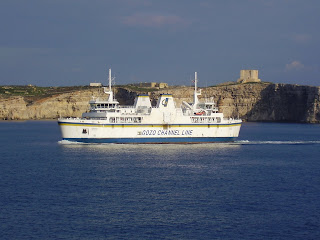 Gozo Ferry
Gozo Ferry Mgarr
MgarrFrom the natural sights and caves to the oldest temples in the world, Gozo has a long history to offer. As a deeply religious population, churches and other religious attractions are also abundant on the island. Various attractions you can visit include the Gozo Museum (historical displays) the Gozo Crafts Centre (good selection of local handicrafts) and the Citadel / Gran Castello. Other island attractions include the Gozo Heritage a series of life-size dioramas depicting the island’s past; pretty Xlendi Bay (on the western coast); and at the red-sanded Ramla Bay the reputed Calypso Cave. Near Xagħra are a number of places to see: two Gigantija Temples (1,000 years older than the Pyramids) and the Alabaster Cave(stalactite and stalagmite caves).

 Xlendi Bay
Xlendi Bay On both Gozo and Malta the Arabs built fortified cities in the centre of the islands as defensive capitals, Mdina on Malta and Rabat on Gozo. Whilst the Gozo capital is shown on maps as Victoria, the locals always refer to it as Rabat, Arabic for “The Town”.

 Basilica of St George in Victoria, on the saint's Feast Day.
Basilica of St George in Victoria, on the saint's Feast Day.Even today the roads on Gozo lead up from the coast to Rabat / Victoria and down again. Crowning Rabat and the island is the Citadel from which virtually the whole island and the surrounding seas can be seen. The Citadel is built on one of the many flat-topped hills in the centre of Gozo. The island was very exposed to raiders and up until 1637 the people of Gozo had to take shelter within the Citadel's walls after sunset, due to the frequent Turkish assaults on the island. In 1551 a strong Turkish force overwhelmed the Citadel and carried 6000 of the inhabitants away into slavery. Only 300 Gozitans managed to escape before the capitulation. The walls themselves date from the 16th to the 18th century.

Most of the buildings inside the Citadel are in ruins, but the Old Courts of Law and the Old Governor's Palace are still used as the Law Courts of Gozo. Also there are the Old Prisons with the Armoury of the Knights, the Archeological Museum, the Natural History Museum and the Folklore Museum. The Cathedral with the Bishop's Palace and the Cathedral Museum dominate the Citadel. The Cathedral was designed by the Maltese architect Lorenzo Gafa, in the form of a Latin cross. It was built between 1697 and 1711 on the site of an older church and it is saying something (given the stiff competition) that it is probably the most atmospheric church on the islands. Many of its treasures are displayed in the adjoining cathedral museum. The Folklore Museum is housed in three late medieval style houses featuring the influence of Sicilian architecture. Exhibits consist of agricultural implements, items related to the cotton industry, tools used in different crafts and some traditional costumes. All archeological material found on Gozo is on display in the Archeological Museum, a 17th century house, known as "Casa Bondi". Of special interest are shards of the Ghar Dalam phase 5000 BC found at Ghajn Abdul, probably the oldest ever found on the Maltese Islands. Also on display are Punic-Hellenistic pottery statuettes, amphorae and anchors.Reflecting the religious Gozitan culture, there is an abundance of churches scattered all over the island.

 Gozo - View from the Citadel
Gozo - View from the CitadelThe most interesting are the Sanctuary Basilica at Ta' Pinu built from 1920 till 1931in Romanesque style, on the remnants of a 16th century chapel, as well as the Rotunda Church of Xewkija, with the third largest dome in Europe (86 metres in circumference and 75 metres high). Xewkija, which lies in the middle between Mgarr Harbour and Victoria, is the oldest village in Gozo. The village feast of St. John the Baptist falls on 24th June, and the external festivities are celebrated on the closest Sunday. The word Xewkija is derived from Arabic meaning an area of thorny wastelands, common at some point in time. The awesome Rotunda, naturally dedicated to St. John the Baptist, is Xewkija's distinctive landmark and parish church. Tourists and visitors flock year round to visit the church and its attractions. It offers an unforgettable panoramic view of Gozo from its enormous dome. The monumental church is an enormous circular structure in white local limestone. It is called a Rotunda because of its form. Eight concrete columns covered with stone support its elegant dome, 75 metres high, with a 28-metre diameter, and a circumference of 85 metres. This boasts the third largest unsupported dome in the world. Its weight is calculated to around 45,000 tonnes. What is truly remarkable about the Rotunda is that it is totally out of scale with all the other churches on Gozo and it was entirely built by voluntary labour and donations over a 24 year period from 1951. Some of the pride the village feels at its creation can be garnered from the signs on the surprisingly large viewing area on the dome exhorting you to “admire God’s wonderful creation".
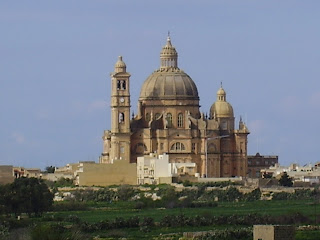 Rotunda Church Xewkija
Rotunda Church Xewkija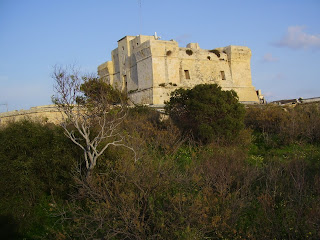
A remnant of Arab culture in the whereabouts of Xewkija is the renowned marble slab of Majmuna (pron. Maimoona) with an inscription in Arabic dating back to 1173. It throws valuable light on life during Arab cultural domination. It also proves that Malta was by that time still under strong Arab influence, even though Arab political domination was ended with the arrival of Count Roger the Norman in 1090.

Gozo is renowned for its cottage industries, particularly spinning and weaving, and the creation of jumpers and jackets from the wool of sheep and goats. Lace is the most widespread doorstep craft. It was introduced on a large scale after the 1840’s. The craft soon proved its worth for the product was sold to the higher classes of society and even abroad. It was very common, especially in the afternoon, to see mothers with their daughters sitting on empty wooden lemonade crates with a lace pillow in their lap rested against the wall, their hands moving bobbins swiftly and deftly creating the most intricate and delicate of designs.
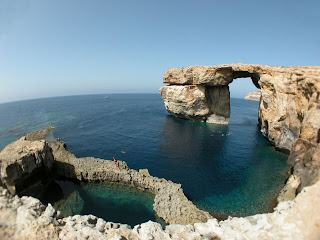 Azur Window
Azur Window Gozo lace is an object d’art and it continues to flourish despite competition from machine made lace. The men make lace of a different variety: silver filigree, twisted into intricate pieces of jewellery. And there is fabulous glass, with remarkable shapes in subtle shades of blue and green. Pottery is widely available, ranging from decorative pots and statuettes to imaginative house name plaques and door numbers.
Gozo is also remarkable for some of oldest Neolithic remains including at Gigantija the oldest free standing structure in the world. These temples in Xagħra, Gozo, are one of the most important archaeological sites in Malta. The origins of Gigantija date back to the Ggantija phase (3600 – 3200 B.C.). John Otto Bayer was the first to excavate the temples in 1827. Extensive archaeological and restoration work was carried out in the early 20th century to ensure their preservation. The Gigantija megalithic complex consists of two temples surrounded by a massive common boundary wall. One of the most striking features of the entire complex, the boundary wall, is built using the alternating header and stretcher technique, with some of the megaliths exceeding five metres in length and weighing over fifty tons. The temples at Gigantija are built with rough, coralline limestone blocks. Each temple contains five apses connected by a central corridor leading to the innermost trefoil section. The first temple is larger and contains a variety of features such as altars, relief carvings and libation holes. The second temple was built later and is devoid of such features. Also of interest is the corbelling technique evident on the inwardly inclined walls, suggesting that the temple was roofed.

The gigantic dimensions of the megaliths have always struck a chord with popular imagination. In centuries past, some locals even believed that the Islands’ temples, in particular those of Ggantija, were the work of giants. This particular temple site in Gozo bears witness to this ancient legend: its name, Gigantija, is Maltese for giant.
The Xagħra Stone Circle.Like the Hal Saflieni Hypogeum, the Xagħra Stone Circle, was used for funerary rites. It was also built on a promontory to the West of a major megalithic site, that of Gigantija Evidence suggests that this site was utilized for burial purposes over the period 4000 - 2500 BC. The Neolithic people at the time made use of a number of natural caves. The Xaghra Stone Circle was originally marked by two entrance monoliths which seem to have been 14 -16 feet high. Although the exact position has not been located, they seem to have been aligned with the Gigantija Temple. These monoliths together with several other megaliths formed part of a wall which circled the entire site. This circle was approximately 45 m in diameter.
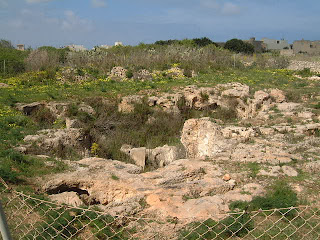 Xagħra stone Circle
Xagħra stone CircleThe interior is composed of a central ritual area entered through a huge stone threshold and down steps into the rough caves. The central chamber is subdivided into two distinct sections by a series of elegant megalithic trilithon altars and a massive stone bowl. Burials were concentrated in smaller caverns, surrounded by rough coralline stone walls. The most important discoveries from the Xaghra stone circle may prove to be the rare but remarkably preserved human remains.
Ta' Cenc Tombs.On the northern lip of Ta’ Cenc, looking across towards Xewkija, three tombs assumed to be of the Early Bronze Age Tarxien Cemetery phase can be found, if carefully sought. The first consists of two rows of upright slabs, perhaps once the walls of a gallery grave. Close to them is a more typical dolmen, with a capstone supported on other blocks. The third is similar, built into a more recent field wall 600m to the east. There may once have been a fourth well off to the south east, but this can no longer be found.
Gozo has four good sets of the mysterious cart-ruts, and a few minor ones. At Tan-Nemes, well east of Qala, a pair runs out onto a spur overlooking the Fliegu ta’ Ghawdex. At Ta’ Tingi, several fine pairs can be found in the olive grove west of the pumping station, just south of Xewkija. An extensive system covers the Ta’ Cenc plateau, best seen between the hotel and the cliffs, and running near, but not to, Borg l-Imramma. They continue for nearly a kilometer to the east. An impressive pair zigzags down the slope from the San Lawrenz quarries to end on the cliffs above the Azure Widow at Dwejra.
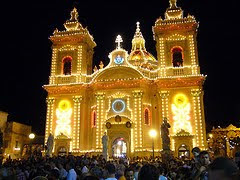
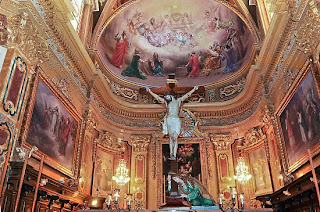
 Marija Bambina Xagħra Church - The feast of the Nativity of Our Lady is celebrated in Xagħra on 8th September of each year. The feast day is also a National Public Holiday otherwise known as Jum il-Vittorja (Victory Day). This is because it recalls the events of the 8th of September 1565, when the Maltese under the Knights of St. John defeated the Ottoman siege of Malta, known as the Great Siege of 1565. This feast is hence locally known also as Il-Madonna tal-Vitorja (Our Lady of Victory).
Marija Bambina Xagħra Church - The feast of the Nativity of Our Lady is celebrated in Xagħra on 8th September of each year. The feast day is also a National Public Holiday otherwise known as Jum il-Vittorja (Victory Day). This is because it recalls the events of the 8th of September 1565, when the Maltese under the Knights of St. John defeated the Ottoman siege of Malta, known as the Great Siege of 1565. This feast is hence locally known also as Il-Madonna tal-Vitorja (Our Lady of Victory).There are two particular feasts which demonstrate the unique Gozitan angle on life, the Carnival and Victory Day. Carnival is celebrated on the five days preceding Ash Wednesday. It usually falls in February. Initiated during the Aragonese rule (before 1530), the celebration has continued to grow and expand. Colourful artistic floats, grotesque masks and dance companies of all ages and sexes parade the streets of the town and the main villages throughout the five days. A spontaneous carnival is organised after sunset in the villages of Nadur and Xewkija. Hundreds of people walk up and down the main street dressed in comically distorted figures and the most imaginative and creative costumes and masks to conceal their identity. The week from Palm Sunday to Easter Sunday, known in the Christian calendar as Holy Week, is full of religious and folklore displays. The central event is the Good Friday procession during which several life-size statues representing various moments from the passion and death of Christ are paraded through the village streets. Several men make vows to walk in the procession carrying a heavy cross or dragging heavy iron chains tied to their ankles. They wear hoods to conceal their identity. Scores of boys and young men are dressed in period costumes to add to the pageantry. Most impressive is the Roman legion, a gleam of breastplates, spears and shields and who announce themselves with trumpets and drum rolls. The procession is accompanied by the village band.
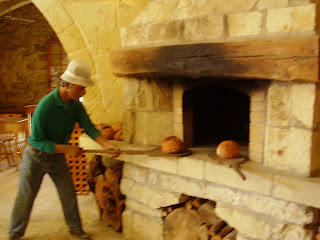 Bakery
BakeryVictory day is celebrated on the 8th of September. On this day the Maltese celebrate the feast of the Nativity of the Virgin Mary as well as the end of the 1565 Great Siege, when the Knights of St. John aided by the Maltese inflicted on the Turks a great defeat. There is a pontifical mass at the cathedral and a military parade in Pjazza Indipendenza. A scholar delivers a speech to commemorate what is perhaps the greatest victory in Maltese history.
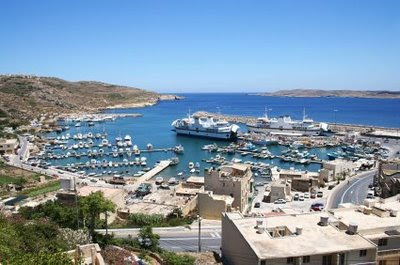 Mgarr Harbour
Mgarr HarbourGozo’s strong sense of identity is manifested in its unique and complex history, its crafts and music, its many village festa, its strong identification with the catholic religion and its rural traditions. It even has its own ministry in the Maltese government. Its inhabitants strongly resisted the building of a bridge across the Gozo channel to Malta. For all that it is both a proud and welcoming place, proud of its identity and happy to be a place apart. There is no fear in walking about at night. The sense of safety and security is tangible. The people take pride in the absolute absence of muggings and the almost non-existence of theft. Until fairly recently, when they were not at home, the villagers of Gozo left their keys in their front doors, a custom which can occasionally still be seen.
 Xagħra Neolothic statuettes
Xagħra Neolothic statuettesGozo is tranquil, and treasures its peace. For some, the silence can be overwhelming, but not to those for whom it spells a blessed a blessed respite from the trials and tribulations of everyday life. Gozo is not for those who like wild clubbing. Change is slow in Gozo, which adamantly sticks to its tortoise-like pace. Gozo has still succeeded in retaining its qualities of peace and solitude. If Odysseus were to come here today, he would probably find it even harder to leave.
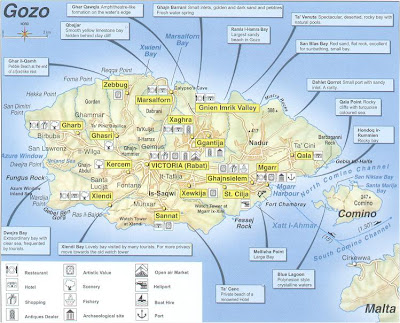 Map of Gozo
Map of Gozo Click for larger version
See also;
Neolithic Malta
http://daithaic.blogspot.com/2008/02/neolithic-malta.html
Knights of Malta
http://daithaic.blogspot.com/2008/03/knights-of-malta.html travel
travel































